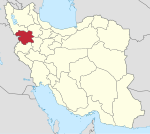Uraman Takht
Uraman Takht
| |
|---|---|
City | |
 The city of Uraman Takht | |
| Coordinates: 35°15′05″N 46°15′40″E / 35.25139°N 46.26111°E[1] | |
| Country | Iran |
| Province | Kurdistan |
| County | Sarvabad |
| District | Uraman |
| Population (2016)[2] | |
• Total | 3,176 |
| Time zone | UTC+3:30 (IRST) |
Uraman Takht (Persian: اورامان تخت)[a] is a city in, and the capital of, Uraman District of Sarvabad County, Kurdistan province, Iran.[4] It also serves as the administrative center for Uraman Takht Rural District.[5]
History
[edit]During the Iran-Iraq war, Uraman Takht, as the center of Uraman region, came under the control of the Sipay Rizgari group led by Sheykh Osman Naqshbandi. In September-October 1981, it was at the center of a battle for control over the region, before being recaptured by Iranian forces. Approximately 50 Sipay Rizgari fighters were killed and 200 captured by Iranian forces during the battle for the city.[6]
Demographics
[edit]Ethnicity
[edit]The city is populated by Kurds.[7]
Population
[edit]At the time of the 2006 National Census, Uraman Takht's population was 2,754 in 644 households, when it was a village in Uraman Takht Rural District.[8] The following census in 2011 counted 2,761 people in 711 households.[9] The 2016 census measured the population as 3,176 people in 911 households,[2] by which time Uraman Takht had been elevated to the status of a city.[10]
See also
[edit]Notes
[edit]- ^ Also romanized as Ooraman Takht and Ūrāmān Takht; also known as Avromān, Owrāmān, Owrāmān Shahr, Shehr-i-Avrōman, and Ūrāmān; Hawrami Kurdish: ھەورامان تەخت, romanized as Hewraman Text[3]
References
[edit]- ^ OpenStreetMap contributors (29 December 2024). "Uraman Takht, Sarvabad County" (Map). OpenStreetMap (in Persian). Retrieved 29 December 2024.
- ^ a b Census of the Islamic Republic of Iran, 1395 (2016): Kurdistan Province. amar.org.ir (Report) (in Persian). The Statistical Center of Iran. Archived from the original (Excel) on 8 May 2022. Retrieved 19 December 2022.
- ^ Uraman Takht can be found at GEOnet Names Server, at this link, by opening the Advanced Search box, entering "-3077525" in the "Unique Feature Id" form, and clicking on "Search Database".
- ^ Aref, Mohammad Reza (9 May 1394) [27 May 1382]. Divisional reforms in Kurdistan province. rc.majlis.ir (Report) (in Persian). Ministry of the Interior, Political-Defense Commission of the Government Board. Proposal 1.4.42.14695; Letter 58538; Notification 8063T/24027H. Archived from the original on 29 April 2015. Retrieved 22 January 2024 – via Islamic Parliament Research Center.
- ^ Mousavi, Mirhossein (14 September 1394) [Approved 18 May 1366]. Creation and formation of 12 rural districts including villages, farms and places in Marivan County under Kurdistan province. rc.majlis.ir (Report) (in Persian). Ministry of the Interior, Board of Ministers. Proposal 1407.1.5.53. Archived from the original on 5 September 2015. Retrieved 22 January 2024 – via Islamic Parliament Research Center.
- ^ "عملیات اورامان تخت و پایان عمر سیاسی گروهک رزگاری" [The Owraman Takht operation and the end of the political life of Rizgari group]. Šabake-ye Ettelāresāni-ye Rāh-e Dānā (in Persian). 13 February 2017.
- ^ Mohammadirad, Masoud; Anonby, Erik; et al. "Language distribution in Kordestan Province, Iran". Atlas of the languages of Iran (ALI). Geomatics and Cartographic Research Centre, Carleton University. Archived from the original on 28 May 2023.
- ^ Census of the Islamic Republic of Iran, 1385 (2006): Kurdistan Province. amar.org.ir (Report) (in Persian). The Statistical Center of Iran. Archived from the original (Excel) on 20 September 2011. Retrieved 25 September 2022.
- ^ Census of the Islamic Republic of Iran, 1390 (2011): Kurdistan Province. irandataportal.syr.edu (Report) (in Persian). The Statistical Center of Iran. Archived from the original (Excel) on 19 January 2023. Retrieved 19 December 2022 – via Iran Data Portal, Syracuse University.
- ^ Rahimi, Mohammad Reza (c. 2024) [Approved 8 December 1389]. Approval letter regarding the transformation of Uraman Takht village, the center of Uraman District of Sarvabad County in Kurdistan province, into a city. lamtakam.com (Report) (in Persian). Ministry of the Interior, Political and Defense Commission. Proposal 156939/42/1; Letter 158802/T38854H; Notification 8527/T31731K. Archived from the original on 22 January 2024. Retrieved 22 January 2024 – via Lam ta Kam.



